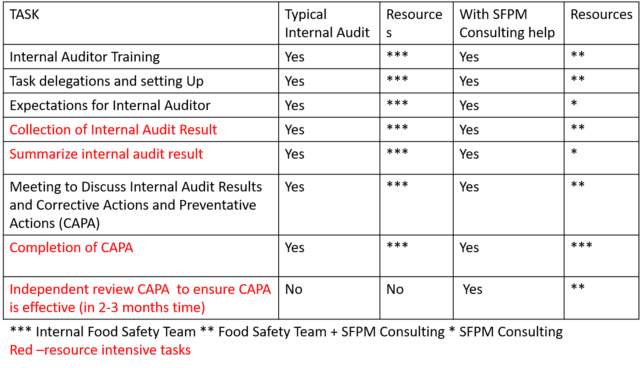Introduction to Internal Audit
Internal audit is the process by which food safety systems are analyzed against the written program to ensure the program is implemented correctly. Internal audit is a required component to meet food safety audit requirements for GFSI recognized certification schemes such as SQF, BRC and FSSC 22000.
It is recommended that the internal audits are conducted by another department independent from the audited department. This makes perfect sense as it eliminates bias from the inspector. However, these also create multiple challenges for completing the internal audit, including a high level of commitment from another department, etc.
The Drawback of Internal Audit
Internal audit is a highly resource-intensive process, which often is managed by Quality Assurance Managers on top of their normal day-to-day firefighting activities. As such, internal audit inherited the challenges of project management, which include
- Borrowing the right personnel that is capable of performing the task from another department or training personnel
- Creating scope management for the project team
- Setting a baseline on the requirement and objectives of the project
- People management to ensure that the project is completed as per schedule
- If required, obtaining additional resources for the internal audit’s findings
- Closing internal audit findings
The Benefit of Internal Audit
Besides being the most tedious task to manage, the internal audit is one of the best indicators for food safety program implementation. It can also be used to measure a food facility’s readiness to move towards process improvement and reap the benefit of a properly implemented food safety program.
The Process
Here is how internal audits are typically run
- Set up an internal audit team (Conduct training, if necessary).
- Opening meeting: Discuss the objectives and scope of the internal audit. Distribution of internal audit tasks and Checklist.
- The Internal Auditor completing the Internal Audit Checklist.
- The Internal Auditor returns the Internal Audit Checklist to the Internal Audit Coordinator.
- The Internal Audit Coordinator compiles audit findings and works with different departments to find suitable corrective and preventative actions.
- The Internal AuditCoordinator presents audit findings and suggested corrective and preventative actions to the internal audit.
- The internal Audit Coordinator issue a corrective and preventative actions request to the relevant department.
- The relevant department completes the corrective and preventative actions and then returns the document to the Internal Audit
- The Internal Audit Coordinator reviews the corrective and preventative actions to be effective and closes the internal audit
The Reality
Often, the Quality Assurance Manager is tasked to be the Internal Audit Coordinator because, ultimately, it is part of their responsibility. Due to the tedious nature of the internal audit process, it is hard to get resources from another department to commit to the internal audit process. The personnel from another department are usually focused on their own day-to-day role.
It is also extremely difficult to set a meeting to ensure team members are not left out. Perhaps, the hardest is to follow up to ensure the department is committed to complete corrective and preventative actions within the agreed timeline.
The Strategies
Here are few tips to make internal audit less stressful:
- Break it down: Divide the internal audit list up to a few smaller internal audit
- Create a comprehensive checklist: Easy to understand by a potential auditor
- Reward & Penalties System: Set and establish member’s commitment to timely completion of internal audit, and corrective actions and preventative actions. Share the status of the internal audit with top management, if necessary.
- KPI for Internal Audit: Make internal audit a part of the food safety team’s Key Performance Index.
- Point of Reference: Set up a reference point to help the internal auditor with questions or challenges that he/she may be encounter.
The Bottom Line
Internal audit is an important tool to ensure our food safety program is what we said they are. If not, we know that what is wrong so that we can work on it.
Personally, I use the internal audit to assess the readiness of a facility to go to the next level for process improvement. If the facility isn’t ready for the basic food safety program, adding additional processes can burden the facility. Thus, a priority should be given to set the foundation of the food safety program.
Tight on Human Resources?
Here is how we can help:

How SFPM Consulting Help With Internal Audit
Don’t stress out your food safety team. Let them focus on the actual organization goals and shift the internal audit focus on us. We’d like to help you make the best out of your food safety program and leverage the existing program to deliver an exceptional return on investment.
